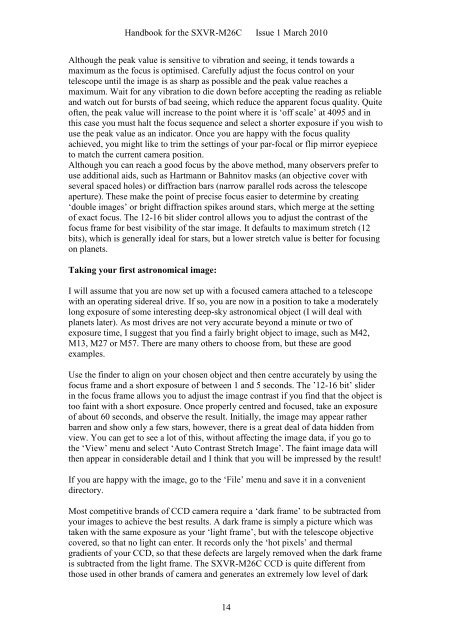SXVR-M26C handbook.pdf - Starlight Xpress
SXVR-M26C handbook.pdf - Starlight Xpress
SXVR-M26C handbook.pdf - Starlight Xpress
Create successful ePaper yourself
Turn your PDF publications into a flip-book with our unique Google optimized e-Paper software.
Handbook for the <strong>SXVR</strong>-<strong>M26C</strong> Issue 1 March 2010<br />
Although the peak value is sensitive to vibration and seeing, it tends towards a<br />
maximum as the focus is optimised. Carefully adjust the focus control on your<br />
telescope until the image is as sharp as possible and the peak value reaches a<br />
maximum. Wait for any vibration to die down before accepting the reading as reliable<br />
and watch out for bursts of bad seeing, which reduce the apparent focus quality. Quite<br />
often, the peak value will increase to the point where it is ‘off scale’ at 4095 and in<br />
this case you must halt the focus sequence and select a shorter exposure if you wish to<br />
use the peak value as an indicator. Once you are happy with the focus quality<br />
achieved, you might like to trim the settings of your par-focal or flip mirror eyepiece<br />
to match the current camera position.<br />
Although you can reach a good focus by the above method, many observers prefer to<br />
use additional aids, such as Hartmann or Bahnitov masks (an objective cover with<br />
several spaced holes) or diffraction bars (narrow parallel rods across the telescope<br />
aperture). These make the point of precise focus easier to determine by creating<br />
‘double images’ or bright diffraction spikes around stars, which merge at the setting<br />
of exact focus. The 12-16 bit slider control allows you to adjust the contrast of the<br />
focus frame for best visibility of the star image. It defaults to maximum stretch (12<br />
bits), which is generally ideal for stars, but a lower stretch value is better for focusing<br />
on planets.<br />
Taking your first astronomical image:<br />
I will assume that you are now set up with a focused camera attached to a telescope<br />
with an operating sidereal drive. If so, you are now in a position to take a moderately<br />
long exposure of some interesting deep-sky astronomical object (I will deal with<br />
planets later). As most drives are not very accurate beyond a minute or two of<br />
exposure time, I suggest that you find a fairly bright object to image, such as M42,<br />
M13, M27 or M57. There are many others to choose from, but these are good<br />
examples.<br />
Use the finder to align on your chosen object and then centre accurately by using the<br />
focus frame and a short exposure of between 1 and 5 seconds. The ’12-16 bit’ slider<br />
in the focus frame allows you to adjust the image contrast if you find that the object is<br />
too faint with a short exposure. Once properly centred and focused, take an exposure<br />
of about 60 seconds, and observe the result. Initially, the image may appear rather<br />
barren and show only a few stars, however, there is a great deal of data hidden from<br />
view. You can get to see a lot of this, without affecting the image data, if you go to<br />
the ‘View’ menu and select ‘Auto Contrast Stretch Image’. The faint image data will<br />
then appear in considerable detail and I think that you will be impressed by the result!<br />
If you are happy with the image, go to the ‘File’ menu and save it in a convenient<br />
directory.<br />
Most competitive brands of CCD camera require a ‘dark frame’ to be subtracted from<br />
your images to achieve the best results. A dark frame is simply a picture which was<br />
taken with the same exposure as your ‘light frame’, but with the telescope objective<br />
covered, so that no light can enter. It records only the ‘hot pixels’ and thermal<br />
gradients of your CCD, so that these defects are largely removed when the dark frame<br />
is subtracted from the light frame. The <strong>SXVR</strong>-<strong>M26C</strong> CCD is quite different from<br />
those used in other brands of camera and generates an extremely low level of dark<br />
14
















